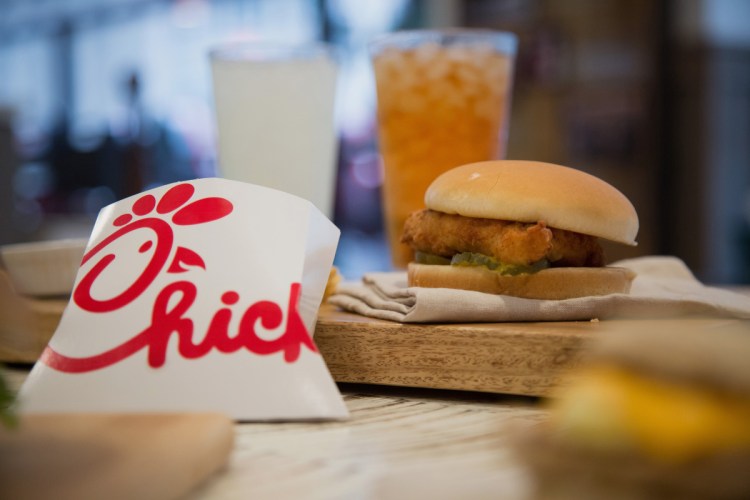By 2022, the minimum wage in California will rise to $15. But the owner of a Chick-fil-A restaurant in Sacramento plans to go ahead and raise the wages of his employees now, offering a huge bump to $17 to $18 from the $12 to $13 he pays them now.
The sizable raise represents a possible new high-water mark for fast-food workers at a time when competition for even unskilled labor is rising amid low unemployment, greater immigration scrutiny and fewer teenagers seeking to work in fast-food jobs. Although restaurant industry analysts can’t say whether a $17 to $18 hourly wage is the highest in the country for front-line fast-food workers, it certainly appears to be among the higher ones, said David Henkes, a senior principal with Technomic, a restaurant research and consulting firm.
“We’re seeing a lot of operators that are in that $12 to $15 range, especially in higher price areas like California, but that’s sort of a new threshold,” he said. “In an era of 3.9 percent unemployment, restaurants – which typically are not seen as the most attractive of jobs – are struggling to not only fill jobs, but then retain workers.”
The owner of the Chick-fil-A location in Sacramento, Eric Mason, told a reporter for the local ABC news affiliate KXTV that he would be raising his workers’ pay from $12-$13 an hour to $17-$18 an hour starting June 4, referring to the increase as a “living wage.” In California, the minimum wage is currently $11 for employers with 26 or more workers and will go up $1 a year until 2022.
“As the owner, I’m looking at it big picture and long term,” Mason said in an interview with the local news station. “What that does for the business is provide consistency, someone that has relationships with our guests, and it’s going to be building a long-term culture.”
A marketing staffer reached at Mason’s location said all questions were being referred to Chick-fil-A’s corporate office. A spokeswoman for the chain confirmed the wage figures and noted that restaurants are individually owned and operated, leaving wage and benefit decisions to local owners.
Restaurant analysts said that unlike retailers that have publicized wage increases above the minimum wage, fast-food restaurants tend to be operated by franchisees, making it trickier to set companywide standards. (McDonald’s said in 2015 that it was raising pay at its company-owned stores to $1 over the minimum wage, but according to recent media reports, some haven’t kept pace.) Many restaurant chains also operate on even tighter margins, making it harder to raise wages without raising prices for consumers or cutting into profitability.
But the high cost of turnover in the restaurant business – the turnover rate in the restaurants and accommodations sector was 73 percent in 2016, according to Bureau of Labor Statistics data – could mean a raise is canceled out by savings in retraining and hiring new workers, said Warren Solochek, senior vice president of industry relations for the food service practice at NPD Group.
That’s particularly so for a chain like Chick-fil-A, which has a reputation for its customer service and prides itself on friendly employees, he said: “You can’t have that high level of service when you continually hire people and have to train people. You need people who’ve been in their job for a while. That’s Chick-fil-A’s reputation, and that’s very true across the country.”
Solochek and Henkes said that although automation is coming to the restaurant industry, tech isn’t replacing many workers quite yet. Digital food ordering may limit the number of people needed at the counter, but it shifts the demand for workers to food preparation in the back. Meanwhile, placing kiosks in restaurants doesn’t mean customers end up using them. “I think it’s going to be a really long time before automation starts to replace workers in a big way,” Solochek said.
Still, many workers in the industry face low pay and little in the way of benefits, despite efforts like the Fight for $15 campaign, which has helped raise minimum wages in many states and cities. Median hourly pay for fast-food workers is just $8.26, according to data from PayScale, and benefits for many part-time fast-food workers are quite limited, forcing many to rely on public assistance or work multiple jobs.
One other restaurant chain had some good news for workers Tuesday: After JAB Holding Co. said Tuesday it would be acquiring Pret A Manger, the British coffee and sandwich chain that has been expanding in the United States, CEO Clive Schlee tweeted that “as we welcome JAB, we’ll be thanking the people who really matter by giving each of our 12,000 employees 1,000 pounds when the deal completes.” A spokeswoman for the chain said the award, equal to about $1,300, was given to “ensure that everyone around the world at Pret is able to share in the celebration.”
Henkes said “it’s exceedingly rare for an acquisition to mean anything positive for hourly workers,” and that it has something in common with the Chick-fil-A owner’s raise.
“Whether it’s giving perks or incentives or higher pay to workers, it’s to create loyalty and hopefully cause them to stay,” he said.
Send questions/comments to the editors.



Comments are no longer available on this story